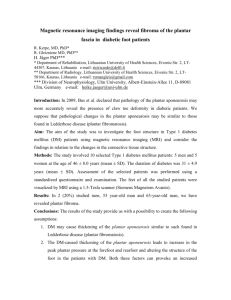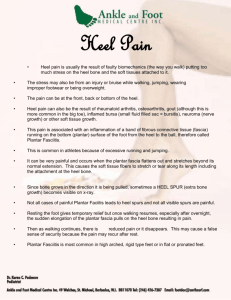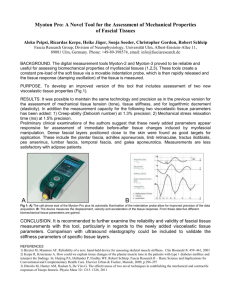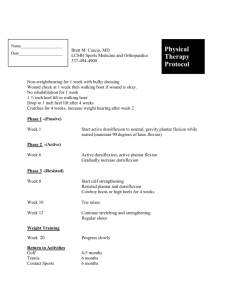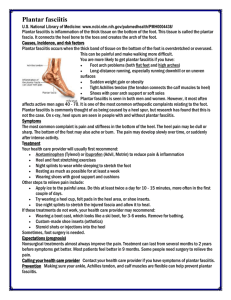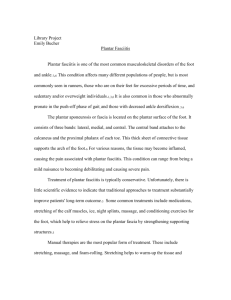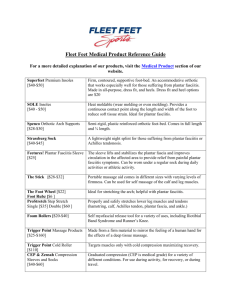Plantar Fascia: Imaging Diagnosis and Guided
advertisement
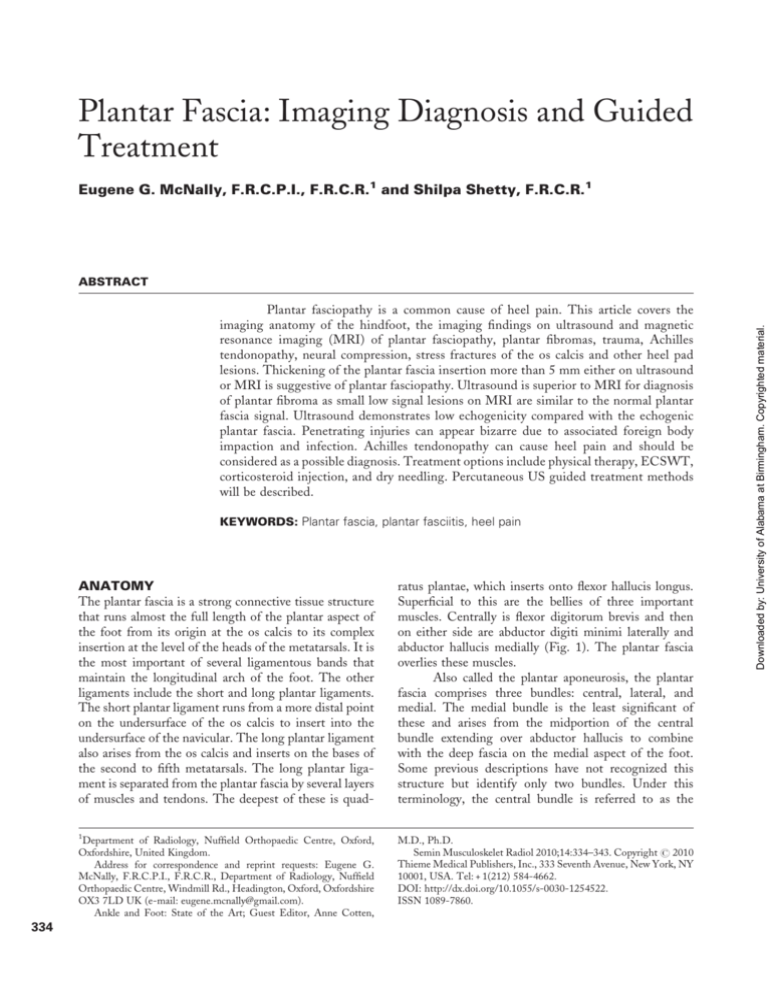
Plantar Fascia: Imaging Diagnosis and Guided Treatment Eugene G. McNally, F.R.C.P.I., F.R.C.R.1 and Shilpa Shetty, F.R.C.R.1 Plantar fasciopathy is a common cause of heel pain. This article covers the imaging anatomy of the hindfoot, the imaging findings on ultrasound and magnetic resonance imaging (MRI) of plantar fasciopathy, plantar fibromas, trauma, Achilles tendonopathy, neural compression, stress fractures of the os calcis and other heel pad lesions. Thickening of the plantar fascia insertion more than 5 mm either on ultrasound or MRI is suggestive of plantar fasciopathy. Ultrasound is superior to MRI for diagnosis of plantar fibroma as small low signal lesions on MRI are similar to the normal plantar fascia signal. Ultrasound demonstrates low echogenicity compared with the echogenic plantar fascia. Penetrating injuries can appear bizarre due to associated foreign body impaction and infection. Achilles tendonopathy can cause heel pain and should be considered as a possible diagnosis. Treatment options include physical therapy, ECSWT, corticosteroid injection, and dry needling. Percutaneous US guided treatment methods will be described. KEYWORDS: Plantar fascia, plantar fasciitis, heel pain 334 ANATOMY The plantar fascia is a strong connective tissue structure that runs almost the full length of the plantar aspect of the foot from its origin at the os calcis to its complex insertion at the level of the heads of the metatarsals. It is the most important of several ligamentous bands that maintain the longitudinal arch of the foot. The other ligaments include the short and long plantar ligaments. The short plantar ligament runs from a more distal point on the undersurface of the os calcis to insert into the undersurface of the navicular. The long plantar ligament also arises from the os calcis and inserts on the bases of the second to fifth metatarsals. The long plantar ligament is separated from the plantar fascia by several layers of muscles and tendons. The deepest of these is quad- ratus plantae, which inserts onto flexor hallucis longus. Superficial to this are the bellies of three important muscles. Centrally is flexor digitorum brevis and then on either side are abductor digiti minimi laterally and abductor hallucis medially (Fig. 1). The plantar fascia overlies these muscles. Also called the plantar aponeurosis, the plantar fascia comprises three bundles: central, lateral, and medial. The medial bundle is the least significant of these and arises from the midportion of the central bundle extending over abductor hallucis to combine with the deep fascia on the medial aspect of the foot. Some previous descriptions have not recognized this structure but identify only two bundles. Under this terminology, the central bundle is referred to as the 1 Department of Radiology, Nuffield Orthopaedic Centre, Oxford, Oxfordshire, United Kingdom. Address for correspondence and reprint requests: Eugene G. McNally, F.R.C.P.I., F.R.C.R., Department of Radiology, Nuffield Orthopaedic Centre, Windmill Rd., Headington, Oxford, Oxfordshire OX3 7LD UK (e-mail: eugene.mcnally@gmail.com). Ankle and Foot: State of the Art; Guest Editor, Anne Cotten, M.D., Ph.D. Semin Musculoskelet Radiol 2010;14:334–343. Copyright # 2010 Thieme Medical Publishers, Inc., 333 Seventh Avenue, New York, NY 10001, USA. Tel: + 1(212) 584-4662. DOI: http://dx.doi.org/10.1055/s-0030-1254522. ISSN 1089-7860. Downloaded by: University of Alabama at Birmingham. Copyrighted material. ABSTRACT PLANTAR FASCIA: IMAGING DIAGNOSIS AND GUIDED TREATMENT/MCNALLY, SHETTY 335 Figure 1 Coronal T1-weighted image through the midfoot showing the important anatomical structures related to the central and lateral bands of the plantar fascia (ovals). The muscles: ADM, abductor digiti minimi; AH, abductor hallucis; FDB, flexor digitorum brevis; QP, quadratus plantae. The nerves: LP, lateral plantar nerve; MP, medial plantar nerve. The tendons: FDL, flexor digitorum longus; FHL, flexor hallucis longus; PB, peroneal brevis; PL, peroneus longus. medial bundle; this should not be confused with the true medial bundle. For the remainder of this article, the three-bundle terminology is used. The central bundle is the most important of the three bundles and the one most commonly affected by disease. It runs from the medial tubercle of the os calcis distally and divides into five limbs, each of which blends IMAGING ANATOMY The anatomy of the plantar fascia can be appreciated on either magnetic resonance imaging (MRI) or ultrasound. Sagittal and coronal MR images show the central and lateral bundles and are close in relationship to the underlying muscles, particularly flexor digitorum brevis and abductor digiti minimi. On coronal T1-weighted images, quadratus plantae can be seen deep to flexor digitorum brevis (Fig. 1), and the short and long plantar ligaments can sometimes be identified at its lateral margin. On sagittal images, the calcaneal attachment of the plantar fascia is better appreciated. The fascia is attached to the underlying bone over a distance 1 cm in the sagittal plane. The major component of the attachment is on the anterior surface, but a component of the fibers does extend around the plantar aspect. Ultrasound imaging is generally performed in the sagittal plane. Whereas on MR, the fascia is homogenously of low signal on both T1- and T2-weighted images under normal circumstances (Fig. 2), an internal structure can be appreciated on ultrasound. The pattern comprises echogenic collagen ligament fibers on a background of a low signal matrix. There is often a thicker Figure 2 (A) Sagittal T1-weighted and (B) sagittal fat-suppressed images of the normal plantar fascia (arrows). The fascia is low signal on most MR sequences demonstrating little of its internal structure. Compare this with the ultrasound image demonstrated in Fig. 3. Downloaded by: University of Alabama at Birmingham. Copyrighted material. with the deep fascia and transverse ligaments that themselves combine at the level of the heads of the metatarsals. The lateral bundle lies beneath the abductor digiti minimi. Two branches of the posterior tibial nerve innervate the fascia. The most superficial of these, the medial calcaneal nerve, arises directly from the posterior tibial nerve. The deeper, more important branch is called the first branch of the lateral plantar nerve, which, as the name implies, arises from the lateral plantar nerve. The lateral plantar nerve is the first substantial division of the posterior tibial nerve. SEMINARS IN MUSCULOSKELETAL RADIOLOGY/VOLUME 14, NUMBER 3 2010 plantar fasciitis is used, although, as with tendon and ligament disorders elsewhere, this should more correctly be referred to as plantar fasciopathy. This proposed terminology is a better reflection of the underlying histology, which rarely includes inflammatory cells.1 The other common disorders include trauma leading to plantar fascia rupture and plantar fibromatosis. Plantar fibromatosis is a very distinct entity from plantar fasciopathy and trauma. Plantar fibromatosis tends to involve the distal two thirds of the ligament, although, as discussed later, enlargement at the calcaneal attachment is not uncommon. Plantar fasciitis is usually located at the calcaneal attachment, whereas traumatic injuries occur 2 to 3 cm distal to this (Fig. 4). Figure 3 Sagittal ultrasound image of the normal plantar fascia. This is an image obtained in the standard examination position. The fascia has been measured (dotted line). Superior to this is the heel pad. The reflective surface of the os calcis is shown below (arrow). The fascia normally measures less than 4.5 mm. reflective band on both the superficial and deep surfaces demarcating the ligament (Fig. 3). BIOMECHANICS AND PATHOPHYSIOLOGY The principal stress on the plantar fascia occurs during walking. The ligament is relaxed at the moment of heel strike and tightens maximally at the end of the toe-off phase. Repetitive trauma leads to microtears within the ligament. More overt tears can occur when there is a sudden high-energy impact or as a consequence of foreign body penetration. Microtears at the plantar fascia origin are termed plantar fasciosis. When they become significant and the patient develops symptoms, the term PLANTAR FASCIOPATHY Plantar fasciopathy is a common disorder that generally affects individuals in the fourth to fifth decades. There are several underlying conditions or associations, including an increase in the body mass index and occupations that involve prolonged standing or marching such as in military personnel. Most notable among the medical conditions that can predispose to plantar fasciopathy is diabetes mellitus, but systemic enthesopathy such as with seronegative arthritides (Fig. 5) and rheumatoid arthritis are also important.2 Other associated predisposing factors include chemotherapy, retroviral infection, and, rarely, gonococcus and tuberculosis infection. CLINICAL MANIFESTATIONS Patients with plantar fasciopathy present a typical clinical picture. Pain is most frequently described as sharp rather than dull and is especially prominent first thing in the morning when the patients place their feet on the Figure 4 Sagittal wide field of view (panorama) ultrasound image of much of the total length of the plantar fascia demonstrating the typical sites of the most common abnormalities. Plantar fasciitis most commonly occurs at the area marked PF; traumatic injuries commonly occur at the area marked T. Fibromas can occur anywhere, but the area marked F is typical. Downloaded by: University of Alabama at Birmingham. Copyrighted material. 336 Figure 5 Sagittal short tau inversion recovery image of the hindfoot showing combined bony and soft tissue abnormalities. Note the marked edema in the os calcis (arrowheads) and the soft tissue edema at the plantar fascia insertion (arrow) and in the pre-Achilles bursa (short arrow). ground for the first time. This is termed post static dyskinesia. Patients frequently report that walking helps initially, and they often try to stretch the longitudinal arch to try and break down what they feel are painful adhesions. Although walking helps initially, the pain recurs with further exertion. There is tenderness to palpation at the calcaneal attachment and decreased dorsi flexion. Some patients complain of pain on toe extension. This is called the windlass test. IMAGING Imaging findings in plantar fasciopathy have been described on plain radiography, MR, and ultrasound. The most commonly associated plain film feature is a plantar spur. These are very nonspecific and are frequently not associated with plantar fascial disease. On good-quality plain radiographs, the presence of a plantar spur should prompt a careful examination of the surrounding soft tissues, and occasionally the swollen plantar fascia may be identified.3 The plain radiograph should also be scrutinized for other features of enthesopathy, including bony erosions both at the plantar fascial attachment and at the Achilles tendon insertion. The principal findings on MR imaging in plantar fasciopathy are a diffuse thickening of the fascia with replacement of the normal low signal on T1 by areas of intermediate signal or the replacement of the normal low signal with linear bands or lobules of increased signal.4 As the disease progresses, high signal changes may also be identified in the surrounding soft tissues on fluid-sensitive sequences. Plantar fasciopathy is not infrequently associated with enthesopathy which manifests as increased signal at the bony attachment, again, best appreciated on fluid-sensitive sequences. Bony spur formation can be demonstrated; the sagittal T1-weighted images Figure 6 Sagittal ultrasound examination demonstrating marked swelling (arrow) and loss of reflectivity and organization of the internal structure, typical of plantar fasciitis. are best for this. When bony changes at the plantar fascial attachment are marked, the Achilles insertion should also be carefully scrutinized. The presence of tendinopathy, enthesopathy, and pre-Achilles bursitis should prompt a diagnosis of seronegative arthropathy. Coronal MR images are best to differentiate the involvement of the central versus the lateral bundles. It is not uncommon to see a very significant enlargement of the central bundle with no abnormality whatsoever in the lateral bundle. The findings on ultrasound mirror the MR abnormalities. The plantar fascia is thickened with a superior to inferior dimension >4.5 mm (Fig. 6). More importantly there is disorganization of the normal reflective structure and loss of the normal organized ligament architecture. Bony involvement is not as easily appreciated, as on MR, although in more advanced stages there is interruption of the bony cortex with a dot/dash appearance. Plantar spur formation, however, can be easily detected. Increased Doppler signal within the swollen plantar fascia is not common, although it is occasionally detected. DIFFERENTIAL DIAGNOSIS OF PLANTAR FASCIOPATHY The clinical features of plantar fasciopathy are typical, and post static dyskinesia in particular usually indicates the diagnosis. Thus in some respects there is a significant overlap between true plantar fasciitis and patients with plantar fasciitis and a traumatic partial tear. In atypical cases or in cases where the imaging findings do not confirm plantar fasciitis, a differential diagnosis should be considered, which includes trauma, plantar fibroma, Achilles tendinopathy, neuropathy, stress fracture particularly of the os calcis, soft tissue lesions in the heel pad, and occasionally vascular causes. 337 Downloaded by: University of Alabama at Birmingham. Copyrighted material. PLANTAR FASCIA: IMAGING DIAGNOSIS AND GUIDED TREATMENT/MCNALLY, SHETTY SEMINARS IN MUSCULOSKELETAL RADIOLOGY/VOLUME 14, NUMBER 3 Trauma Traumatic injuries to the plantar fascia are much less common than plantar fasciitis. One of the principal differentiating features is the location of the lesion, which tends to involve the plantar fascia 2 to 3 cm from the insertion (Fig. 4). Injuries can be acute or subacute. Acute injuries are often related to a strong axial compression force, for example, if the patient jumps from a height. The force on the plantar fascia is increased on uneven landing surfaces, particularly when the forefoot strikes the ground on contact point first and the heel later. A typical scenario is a tumble from a modest height, like when the forefoot strikes the edge of the curb with increased dorsiflexion. The patient complains of an acute pain often accompanied by a snapping sound. Bruising may be detected at the site of the injury, and point tenderness is palpated 2 to 3 cm from the ligament insertion. Subacute injuries may develop as a consequence of chronic subclinical plantar disease. In these instances, the history is more difficult to differentiate from plantar fasciitis because the underlying etiology in both entities is chronic misuse. Thus in some respects there is a significant overlap between true plantar fasciitis and patients with plantar fasciitis that end up with a traumatic partial tear. The imaging characteristics of the traumatic lesion are similar to plantar fasciitis other than they occur, as previously described, in a different location. Traumatic injuries tend to have more focal areas of high signal, which are often confluent. The superficial fibers are more often affected than the deep fibers. Penetrating injuries are associated with more bizarre patterns but are characterized by greater involvement of the heel pad and superficial structures. They often demonstrate a linear component marking the track of the nail or other foreign body. Artifact related to residual metal fragments may also be present. Superadded infection is a significant risk 2010 associated with these injuries, which will further alter the imaging appearances. Plantar Fibroma In most cases, it is relatively easy to differentiate plantar fibroma from other plantar fascial lesions. It is recognized, however, that plantar fibromatosis may be associated with thickening of the plantar fascia at the bony attachment, which mimics the appearances of the plantar fasciopathy. When this occurs, in the author’s experience, the classical history of plantar fasciitis is not present. The differential diagnosis therefore of a swollen proximal patellar plantar fascia includes plantar fasciopathy, plantar fibromatosis, and diabetic fascial disease, which are discussed later. The diagnosis of plantar fibroma is easily made by carefully following the plantar fascia throughout its length. The typical plantar fibroma appears as a focal, often oval-shaped area with disorganization that is intimately relation to the plantar fascia. Larger lesions may be lobulated and can demonstrate a central scar-like appearance with fibers radiating from the plantar fascia, particularly on the axial images. The MR appearances of plantar fibroma can take on several patterns. A common appearance is of a lobulated mass of low signal intensity representing the fibrous nature of these lesions (Figs. 7A and B). In some instances the lesion may return high signal on T2-weighted or short tau inversion recovery images, with an organized internal architecture having alternating vertical low signal bands (Figs. 8A and B). On the T1-weighted images, it is common to see large areas of low signal, but occasionally signal that is isointense with muscle can be appreciated. On ultrasound, the lesions demonstrate mixed, predominantly low reflectivity. Occasionally plantar fibroma shows increased Doppler signal on ultrasound; however, this is by no means Figure 7 (A) Coronal fat-suppressed proton-density image and (B) sagittal T1-weighted image of another small plantar fibroma (arrow). Once again the intimate relationship of the lesion to the plantar fascia is demonstrated. Lesions in the more distal plantar fascia may be easier to detect because there is a fat plane rather than a muscle plane deep to the fascia. Downloaded by: University of Alabama at Birmingham. Copyrighted material. 338 Figure 8 (A) Coronal fat-suppressed proton-density and (B) T1-weighted images of plantar fibroma (arrow). These lesions can have several types of appearance on magnetic resonance imaging. Some lesions are uniformly low signal, whereas others demonstrate a more organized internal structure with alternating vertical low signal bands as in this case. Signal characteristics are also variable, although predominantly low signal is encountered on T2-weighted images. In this case, the low signal is predominantly found within the fibrous architecture. The location of the lesion obviously arising from the plantar fascia is also typical. universal. Ultrasound has several advantages over MRI in the diagnosis of plantar fibromatosis. The presence of multiple lesions centered on the plantar fascia is characteristic. Some of these multiple lesions may be small, and on MR small low-reflective lesions can be difficult to differentiate from the low-intensity plantar fascia. Small lesions are more easily detected on ultrasound because the contrast between the poorly reflective fibroma and the brighter, striated plantar fascia is more obvious (Figs. 9A and B). Also, it is easier to examine both feet under high resolution with ultrasound. Examining both feet together with MRI reduces the in-plane resolution and is not recommended. It is possible to examine both feet separately, of course; however, this is time consuming when compared with ultrasound. Achilles Tendinopathy It may seem surprising to include Achilles tendinopathy in the differential diagnosis of plantar fascia. However, perhaps because of dermatomal innervation, some other neural cause, or anatomical continuity in fibers from the Achilles tendon to the plantar fascia,5 the symptoms of chronic Achilles tendinopathy and chronic plantar fasciitis on occasion can be similar. Therefore, investigation of one entity can be followed by the diagnosis of the other, even with referrals from expert foot specialists. Consequently, both structures should be carefully scrutinized even when symptoms point to one or the other. This is especially true for ultrasound examination because, in most instances; the field of view used for MRI Figure 9 Sagittal ultrasound images of the midfoot. The heel is to the right and the toes to the left with the plantar aspect of the foot superiorly. (A) The figure on the left demonstrates a very small plantar fibroma (horizontal arrow). It has low reflectivity and no internal organization, and it is intimately related to the adjacent plantar fascia (vertical arrow). Lesions of this size may be very difficult to detect on magnetic resonance imaging. (B) The image on the right is a much larger fibroma (arrow). Arrowheads mark the proximal and distal ends of the lesion. 339 Downloaded by: University of Alabama at Birmingham. Copyrighted material. PLANTAR FASCIA: IMAGING DIAGNOSIS AND GUIDED TREATMENT/MCNALLY, SHETTY SEMINARS IN MUSCULOSKELETAL RADIOLOGY/VOLUME 14, NUMBER 3 2010 Figure 10 (A) Sagittal T1-weighted and (B) sagittal short tau inversion recovery sequence of the hindfoot. The T1-weighted image shows thickening and decreased reflectivity in the plantar fascia typical of plantar fasciitis (arrow). The wider field of view in (B) shows that the patient also has thickening of the midportion of the Achilles tendon. In comparison with Fig. 5, the location of the abnormality in the Achilles tendon suggests that this is a coexisting biomechanical abnormality rather than an underlying systemic inflammatory disorder. would automatically demonstrate both (Figs. 10A and B). Neural Compression The plantar fascia is innervated by two nerves, which arise from the posterior tibial nerve. The first is the medial calcaneal nerve, which is most commonly the last branch of the posterior tibial nerve before it divides into the medial and lateral plantar nerves. It passes quickly to a superficial location where it lies between the abductor hallucis and the superficial fascia. The second is the first branch of the lateral plantar nerve; this is the name is well as the anatomical description! This nerve passes along the medial border of the os calcis before passing between the abductor hallucis and quadratus plantae muscle. It then passes in a soft tissue tunnel between the abductor hallucis and flexor digitorum brevis before reaching the plantar fascia. The nerve may become entrapped in this location, particularly if there is muscle hypertrophy. The symptoms of nerve entrapment may mimic those of plantar fasciopathy.6 A positive Tinel’s sign (i.e., percussion over the area of entrapment), which is most commonly between quadratus plantae and abductor hallucis, results in pain or paraesthesia in the sensory distribution of the nerve. The condition is sometimes referred to as Baxter’s neuropathy. The inferior calcaneal nerve supplies the motor innervation to the flexor digitorum brevis, the quadratus plantae, and the abductor digiti minimi, and on MRI a neuropathy of this nerve may show fatty atrophy of the abductor digiti minimi muscle.7 An ultrasound-guided injection may be useful as a therapeutic measure. Miscellaneous Causes Other possible diagnoses to be considered in patients presenting with symptoms of plantar fasciitis include stress fractures of the os calcis (Fig. 11), heel pad lesions, and vascular causes. Heel pad lesions include entities such as fat necrosis, which may be the consequence of Figure 11 Sagittal computed tomography (CT) reconstruction demonstrating a short sclerotic line within the os calcis (arrow) indicative of a stress fracture. CT is not as good diagnostically as magnetic resonance imaging (MRI) in the assessment of the adjacent soft tissues; however, scrutiny of orthopaedic CT images should include perusal of the adjacent important soft tissue structures. The Achilles tendon and plantar fascia are both visible on this image. CT, however, may be superior to MRI in making a firm diagnosis of stress fracture, and sometimes the fracture line itself may be obscured by bony edema readily detected by MRI. Downloaded by: University of Alabama at Birmingham. Copyrighted material. 340 Figure 12 Coronal T1-weighted magnetic resonance image to the hindfoot. There is a lobulated mass on the medial aspect of the hindfoot within the subcutaneous fat related to superficial fascia (arrow). The lesion is an hemangioma. injection or trauma. Fat atrophy and fat necrosis present a rather nonspecific appearance on MRI. The lesions are generally poorly defined and of intermediate to high signal on T1-weighted images. Ultrasound is more useful than MRI in detecting whether foreign material is present within the lesion. Occasionally tumors such as hemangioma (Fig. 12) and fibroma may involve the heel pad. Vascular insufficiency may be a cause suggested by other general features such as diminished or absent pulses, trophic skin changes, and loss of hair distally. TREATMENT OPTIONS As in any other condition, the treatment of plantar fasciopathy can be divided into conservative and surgical measures. Conservative measures include weight loss, orthoses, and activity modification as well as physical therapy including stretching and taping measures. Although many patients find the simple measures beneficial, there is no evidence based on randomized control trials for their long-term benefit. Hence they may be recommended for short-term treatment (3 months).8 Interventional methods include corticosteroid injection, which has been shown by randomized controlled trials to offer some short-term benefit,9 and methods that involve controlled reinjury and rehabilitation. Several methods are described for reinjuring the tendon, and several proliferants have also been used to assist with rehabilitation. Methods of reinjury include dry needling therapy and extracorporeal shockwave therapy. Of these, shockwave therapy has received the most attention in the literature. These have been reviewed by Haake et al,10 who conclude that, of the six randomized controlled trials that have been performed of this technique, five showed no benefits, two of which showed possible benefit and only one of which was in favor of this treatment methodology. There are no good studies of dry needling therapy, although many patients describe immediate relief of symptoms following these procedures. Of the proliferants described, the most commonly used is autologous blood, although plateletrich plasma, 50% glucose, and other agents have been used in other tendons and ligaments. In addition to methods directed against the tendon, success has been reported in directing therapy against the abnormal blood vessels that frequently accompany tendinopathy. Sclerosing agents such as aethoxysclerol (Polidocanol) have been used successfully in patients with patellar tendinopathy, Achilles tendinopathy, and tennis elbow. For reasons that are uncertain, vascular proliferation, so-called angioneogenesis, is not a prominent feature of plantar fasciitis. HOW WE DO IT Patients presenting with clinical symptoms of plantar fasciopathy generally undergo an ultrasound examination where there is an intention to proceed to percutaneous therapy if the diagnosis is confirmed. The presumption is that the patient has already undergone a trial of more conservative measures as described earlier. If the diagnosis is confirmed and the patient has undergone physical therapy without success, a corticosteroid injection combined with dry needling therapy is offered. Percutaneous Interventional Techniques The superficial location of the plantar fascia means that it can be easily accessed percutaneously. Several approaches have been described. A common technique uses the plantar aspect of the foot, approaching the plantar fascia origin from either the proximal or distal direction (Fig. 13). The distal puncture has some advantage in terms of the patient’s comfort because the thicker skin overlying the heel does not need to be penetrated. Both of these techniques mean that, if corticosteroid is used, some may remain in the subcutaneous fat and can lead to subcutaneous fat atrophy. The use of methyl prednisolone helps control this risk. We prefer an approach from the medial aspect of the hindfoot. An injection point is chosen such that the needle will pass from medial to the midline coming to lie at the point close to the plantar 341 Downloaded by: University of Alabama at Birmingham. Copyrighted material. PLANTAR FASCIA: IMAGING DIAGNOSIS AND GUIDED TREATMENT/MCNALLY, SHETTY SEMINARS IN MUSCULOSKELETAL RADIOLOGY/VOLUME 14, NUMBER 3 Figure 13 Diagram demonstrating the common percutaneous approach to the plantar fascia. We prefer an approach from the medial side, however. One technique for achieving this is demonstrated in Fig. 15. fascia insertion, deep to it and deep to the superficial fascia. In this location a corticosteroid injection will largely remain in the deep compartment (Fig. 14) between the plantar fascia and flexor digitorum brevis, reducing the likelihood of subcutaneous fat necrosis. At the same time, the medial approach allows easy access to the plantar fascia if dry needling therapy is to be performed. With practice a puncture point that allows access to the plantar fascia and the deep compartment can be easily chosen. In the learning stages, it may be helpful to use some form of guide. A thin metal rod at a 90-degree angle, such as an unfolded paper clip, can be used (Fig. 15). The distal part of the rod is placed on the plantar aspect of the heel beneath the ultrasound probe to identify the point along the plantar fascia close to the insertion (Fig. 16). This avoids the risk of puncturing too far posterior and encountering the medial border of the os calcis. At the same time, a mark can be placed on the metal rod beyond the bend 1.5 cm from the bend, which, in most patients, would be a good depth to puncture the skin. The dry needling procedure is performed using a standard 18-gauge needle. The plantar fascia is punctured in its medial border in the area most heavily 2010 Figure 14 Coronal fat-suppressed proton-density (inverted) image demonstrating plantar fasciitis of the central bundle (arrow). The shaded area outlines a deep compartment protected from the heel pad by the fascia and its extensions. The medial approach aims to place corticosteroid injection in this area with a view to reducing the incidence of heel pad necrosis that may be induced by steroid injection. Figure 15 One method of helping to identify the optimal injection point on the medial aspect. The extended paper clip is placed between the ultrasound probe and the patient’s skin and moved proximately and distally (opposing arrows) until its reflection is seen to lie in the best position to inject the fascia. A puncture point 1.5 cm from the undersurface of the foot is chosen (shaded circle). With practice the injection site can be chosen quickly without the need for this device. Downloaded by: University of Alabama at Birmingham. Copyrighted material. 342 PLANTAR FASCIA: IMAGING DIAGNOSIS AND GUIDED TREATMENT/MCNALLY, SHETTY 343 Figure 16 Sagittal ultrasound image (inverted; the heel pad is in the inferior aspect of the image). A needle is in position (note its reflection, indicated by the arrow). Inverting the image if it is possible, using the available ultrasound equipment, may be helpful to beginners when making needle adjustments. involved. The needle can be moved in a plane paralleling the long axis of the fibers. Several punctures can be made throughout the area of abnormality. In some patients the plantar fascia appears rather firm, whereas in others there is little resistance to the passage of the needle. Some patients find the procedure painful; in others it is well tolerated. 1. Lemont H, Ammirati KM, Usen N. Plantar fasciitis: a degenerative process (fasciosis) without inflammation. J Am Podiatr Med Assoc 2003;93(3):234–237 2. Geppert MJ, Mizel MS. Management of heel pain in the inflammatory arthritides. Clin Orthop Relat Res 1998;(349): 93–99 3. Osborne HR, Breidahl WH, Allison GT. Critical differences in lateral X-rays with and without a diagnosis of plantar fasciitis. J Sci Med Sport 2006;9(3):231–237 4. Theodorou DJ, Theodorou SJ, Resnick D. MR imaging of abnormalities of the plantar fascia. Semin Musculoskelet Radiol 2002;6(2):105–118 5. Snow SW, Bohne WH, DiCarlo E, Chang VK. Anatomy of the Achilles tendon and plantar fascia in relation to the calcaneus in various age groups. Foot Ankle Int 1995;16(7): 418–421 6. Delfaut EM, Demondion X, Bieganski A, Thiron MC, Mestdagh H, Cotten A. Imaging of foot and ankle nerve entrapment syndromes: from well-demonstrated to unfamiliar sites. Radiographics 2003;23(3):613–623 7. Stanczak JD, McLean VA, Yao L. Atrophy of the abductor minimi muscle: marker of neuropathic heel pain syndrome [abstract]. Radiology 2001;221(P):522 8. Landorf KB, Keenan AM, Herbert RD. Effectiveness of foot orthoses to treat plantar fasciitis: a randomized trial. Arch Intern Med 2006;166(12):1305–1310 9. Crawford F, Thomson C. Interventions for treating plantar heel pain. Cochrane Database Syst Rev 2003;(3):CD000416 10. Haake M, Buch M, Schoellner C, et al. Extracorporeal shock wave therapy for plantar fasciitis: randomised controlled multicentre trial. BMJ 2003;327(7406):75 Downloaded by: University of Alabama at Birmingham. Copyrighted material. REFERENCES
